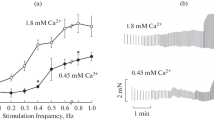Abstract
-
1.
In the rabbit S-A node the factors which control the time course of hyperpolarizations (muscarinic response) induced by ionophoretic application of acetylcholine were studied.
-
2.
The muscarinic response is characterized by an apparent delay of minimally 30 ms and a slow rise to the peak. The time to peak rises continually from about 200 ms to 1,000 ms when the amount of ACh released is increased.
-
3.
For a given strong releasing pulse both peak time and delay time depend on the distance of the pipette tip to the surface of the preparation with a power of 2 for large distances (about >60 μm). For shorter pipette distances the peak time remains constant, and it was concluded that for this location the chemical reactions of agonist binding and channel opening are slow compared to the change of ACh concentration (non-equilibrium) and possibly saturation occurs.
-
4.
Peak shape and total duration of the response are strongly influenced by the activity of the tissue cholinesterase: In the presence of neostigmine the same amount of ACh released produces a larger and longer response. Lowering the temperature from 37°C to 27°C prolongs the peak time by a factor of 1.7–2.1.
-
5.
The hyperpolarizations could be reconstructed on the basis of the Katz-Miledi model including the rate constants of the opening and closing of the ion channel, and the diffusion of the agonist in the sinus node preparation with a low density of muscarinic receptors. The calculations suggest that the apparent delay is mainly due to the kinetics of the ion channel and that diffusion determines the slow time course of the response.
-
6.
The model simulates changes of the external factors which strongly influence the shape of the response (e.g. strength of the releasing pulse, temperature and activity of the cholinesterase).
Similar content being viewed by others
References
Castillo J del, Katz B (1955) Production of membrane potential changes in the frog's heart by inhibitory nerve impulses. Nature 175:1035
Castillo J del, Katz B (1957) Interaction at end-plate receptors between different choline derivatives. Proc R Soc Lond B 146:369–381
Dreyer F, Peper K (1974) Ionophoretic application of acetylcholine: advantages of high resistance micropipettes in connection with an electronic current pump. Pflügers Arch 348:263–272
Dreyer F, Peper K, Sterz R (1978) Determination of dose-response curves by quantitative ionophoresis at the frog neuromuscular junction. J Physiol (Lond) 281:395–419
Garnier D, Nargeot J, Ojeda C, Rougier O (1978) The action of acetylcholine on background conductance in frog atrial trabeculae. J Physiol (Lond) 274:381–396
Glitsch HG, Pott L (1978) Effects of acetylcholine and parasympathetic nerve stimulation on membrane potential in quiescent guinea-pig atria. J Physiol (Lond) 279:655–668
Hartzell HC (1980) Distribution of muscarinic acetylcholine receptors and presynaptic nerve terminals in amphibian heart. J Cell Biol 86:6–20
Hartzell HC, Kuffler SW, Stickgold R, Yoshikami D (1977) Synaptic excitation and inhibition resulting from direct action of acetylcholine on two types of chemoreceptors on individual amphibian parasympathetic neurons. J Physiol (Lond) 271:817–846
Hill-Smith I, Purves RD (1978) Synaptic delay in the heart: an ionophoretic study. J Physiol (Lond) 279:31–54
Hutter OF, Trautwein W (1956) Vagal and sympathetic effects on the pacemaker fibres in the sinus venosus of the heart. J Gen Physiol 39:715–733
Katz B, Miledi R (1972) The statistical nature of the acetylcholine potentials and its molecular components. J Physiol (Lond) 224:665–699
Krnjević K, Mitchell JF (1960) Diffusion of acetylcholine in agar gels and in the rat diaphragm. J Physiol (Lond) 153:562–572
Mittag TW, Ehrenpreis S, Patrick P (1971) Some properties of cholinesterases in intact guinea-pig ileum in vitro. Arch Int Pharmacodyn 191:270–278
Noma A, Irisawa H (1976) Membrane currents in the rabbit sinoatrial node cell as studied by the double microelectrode method. Pflügers Arch 364:45–52
Noma A, Trautwein W (1978) Relaxation of the ACh-induced potassium current in the rabbit sinoatrial node cell. Pflügers Arch 377:193–200
Noma A, DiFrancesco D, Trautwein W (1978) Dose-response curve for acetylcholine (ACh) and carbamylcholine (CCh) in the rabbit S-A node. Pflügers Arch 377:R4
Noma A, Osterrieder W, Trautwein W (1979) The effect of external potassium on the elementary conductance of the ACh-induced potassium channel in the sino-atrial node. Pflügers Arch 381:263–269
Noma A, Peper K, Trautwein W (1979) Acetylcholine-induced potassium current fluctuations in the rabbit sino-atrial node. Pflügers Arch 381:255–262
Osterrieder W, Noma A, Trautwein W (1980) On the kinetics of the potassium channel activated by acetylcholine in the S-A node of the rabbit heart. Pflügers Arch 386:101–109
Peper K, Dreyer F, Müller KD (1975) Analysis of cooperativity of drug-receptor interaction by quantitative ionophoresis at frog motor endplates. Cold Spring Harbor Symp Quant Biol 40:187–192
Pott L (1979) On the time course of the acetylcholine-induced hyperpolarization in quiescent guinea pig atria. Pflügers Arch 380:71–77
Pott L, Pusch H (1979) A kinetic model for the muscarinic action of acetylcholine. Pflügers Arch 383:75–77
Purves RD (1976) Function of muscarinic and nictotinic acetylcholine receptors. Nature 261:149–151
Purves RD (1977) The time course of cellular response to ionophoretically applied drugs. J Theor Biol 65:327–344
Steinbach JH, Stevens CF (1976) Neuromuscular transmission. In: Llinás R, Precht W (eds) Frog neurobiology. Springer, Berlin Heidelberg New York, pp 33–92
Toda N, West TC (1965) Changes in sino-atrial transmembrane potentials on vagal stimulation of the isolated rabbit atrium. Nature 205:808–809
Author information
Authors and Affiliations
Additional information
This work was supported by the Deutsche Forschungsgemeinschaft SFB 38, project G
Rights and permissions
About this article
Cite this article
Osterrieder, W., Yang, Q. & Trautwein, W. The time course of the muscarinic response to ionophoretic acetylcholine application to the S-A node of the rabbit heart. Pflugers Arch. 389, 283–291 (1981). https://doi.org/10.1007/BF00584791
Received:
Accepted:
Issue Date:
DOI: https://doi.org/10.1007/BF00584791




